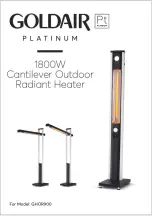
Hot Water
Energy
Storage
Unvented Cylinder
Installation & Maintenance Instructions for an unvented
hot water cylinder with internal thermal expansion
SEPT 2018
18
COMMISSIONING
SERVICING
FLUSHING & FILLING
Check all the connections for tightness
including any factory made connections
such as the immersion heater and the
temperature and pressure relief valve.
Before filling, open the hot tap furthest
away from the unvented cylinder, to let
air out. Open the cold main isolation
valve and allow the unit to fill. When
water flows from the tap allow it to run
for a short while to flush through any
dirt, swarf or flux residue. Close the tap
and open every other hot tap in turn to
purge all remaining air. Fill the system
using mix of mains water and corrosion
inhibitor. Follow inhibitor instructions for
dosing levels.
DIRECT UNITS
After filling with water and after
sterilisation liquid has been purged,
switch on the power to the immersion
heaters and allow the unit to start to
heat. The immersion heater is supplied
preset at 55°C. Turning fully to + sets
to approx 65°C. Allow unit to heat up,
adjust the thermostat so that the heater
switches off at 60°C. Record information
on commissioning check list (Page 26).
INDIRECT UNITS
Consult the boiler manufacturer’s
commissioning instructions and fill
the primary circuit. Ensure the lever on
the two port valve is set to the filling
position. When full, move the lever back.
Switch the programmer to Domestic
Hot Water (DHW) and allow the unit
to start to heat. Adjust the dial of the
dual thermostat to between 55°C and
65°C as required. Allow unit to heat up,
adjust the thermostat so that the heater
switches off at 60°C. Record information
on commissioning check list (Page 26).
STORAGE TEMPERATURE
The recommended storage temperature
for both direct and indirect cylinders
is 60-65°C. In hard water areas
consideration should be given to
reducing this to 50-55°C. In many
healthcare applications the guidance
on Legionella control and safe water
delivery temperatures will require storing
the water at 60-65°C, distributing
at 50- 55°C and using thermostatic
mixing valves to control the final
temperature. For details consult the
NHS Estates Guidance on safe hot water
temperatures.
SAFETY VALVE CHECKS
During heat-up there should have
been no sign of water coming from
either the expansion relief valve or
the temperature/pressure relief valve.
Now hold both of these safety valves
fully open, allowing as much water as
possible to flow through the tundish.
Check that your discharge pipework
is free from debris and is carrying
the water away to waste efficiently.
Release the valves and check that they
reseat properly. On Completion of
commissioning, fill in the Benchmark
check list and leave with the house
owner.
BENCHMARK SCHEME
The installer must follow the Benchmark
code of practice for the Benchmark
certification to be valid. The benchmark
code of practice can be found on the
internet using the following internet site
www.centralheating.co.uk and follow
links.
GENERAL
Servicing should only be carried out by
competent installers and only spare parts
approved by the manufacture may be
used. NEVER bypass any safety devices
or operate the unit without them being
fully operational. For internal inspection
- remove Immersion heater and use
heat boss as inspection port for internal
inspection
DRAINING
Isolate from the electrical supply to prevent
the immersion heaters burning out. Turn
off the boiler. Isolate the unit from the cold
mains. Attach a hose to the draining tap
ensuring that it reaches to a level below
the unit (this will ensure an efficient syphon
is set up and the maximum amount of
water is drained from the unit). First open
the hot tap closest to the unit and then
open the draining tap. Remove immersion
heater and use fitting as an inspection
port. Use of veiwing aid such as endoscope
may be required.
WARNING: WATER DRAINED OFF MAY BE
VERY HOT!
IMPORTANT: After draining the cylinder do
not close the hot tap until the cylinder has
fully cooled, failure to follow this instruction
may result in damage to the cylinder and
will invalidate the guarantee.
ANNUAL MAINTENANCE
The unvented cylinder requires an annual
service in order to ensure safe working and
optimum performance. It is essential that
the following checks are performed by a
competent installer on an annual basis.
1) Twist the cap of the expansion relief
valve on the inlet control set and allow
water to flow for 5 seconds. Release and
make sure it resets correctly. Repeat with
the pressure / temperature relief valve.
In both cases check that the discharge
pipework is carrying the water away
adequately. If not, check for blockages etc.
and clear.
WARNING: THE WATER DISCHARGED MAY
BE VERY HOT!
2) Check that any immersion heaters
fitted are working correctly and that they
are controlling the water at a temperature
between 55°C and 65°C.
3) Inspect supply cord. If the supply cord
is damaged, it must be replaced by a
qualified person in order to avoid a hazard
4) Recharge the expansion space by
following the instructions on page 17. Turn
off the water supply to the unit and open
a hot tap and drop the pressure in the
cylinder. Hold open T&P valve until flow
stops. Release T&P valve and turn water
supply back on. When water flows from
hot tap turn tap off. Check for any leaks.
5) Unscrew the head on the inlet control
set and clean the mesh filter within.
6) The Benchmark Log Book supplied
with this unit should be updated at each
service.
YOUR GUARANTEE MAY BE VOID
WITHOUT PROOF OF ANNUAL SERVICING.











































